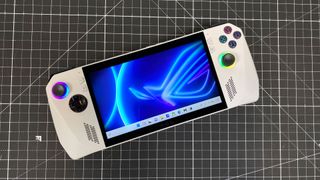Asus ROG Ally gets official AMD Fluid Motion Frames support for universal Frame Gen without custom drivers
Asus has taken a common community tweak and made AMD AFMF a central feature of ROG Ally

The Asus ROG Ally is receiving official support for AMD's Fluid Motion Frames. The company revealed a forum post with official changelog posted to Asus' ROG Forums yesterday. While select ROG Ally users were already using the feature by using custom driver software, this official update from Asus will allow for AMD FMF to be used on ROG Ally, and allows for Frame Generation to be applied to nearly any game— even those without full AMD FSR 3 support.
Since the ROG Ally handhelds have a 16:10 1200p display resolution and run at up to 120 Hz, the addition of AMD FMF is sensible— particularly for the more powerful ROG Ally Z1 Extreme model. AMD recommends only using AMD FMF when you're already reaching 60 frames per second — which would become a smooth 120 Hz on this screen with FMF, as long as you can really hit that FPS cap to begin with. AMD FMF may also work doubling lower FPS (like 40), but the best results will always start at 60 FPS real performance and higher.
Asus ROG Ally users will soon be able to test out AMD's Fluid Motion Frames for themselves via today's iGPU driver and ACSE updates that should already be pushed to their devices. An AFMF toggle is also set to be added to the ROG Command Center at some future update, though for now it has to be enabled in AMD's driver software once the update is complete.
Just because you have the cool feature to enable, Frame Generation still needs a good enough base framerate before you can start using it effectively without worsening input lag. Frame Gen isn't intended to be used on non-playable games to make them "playable." It's intended to make already-playable experiences smoother if the display hardware has the flex room. So, we generally don't recommend enabling Frame Gen on games that you already have trouble running, especially if you can't achieve 40-60 FPS or higher, on average.
Stay On the Cutting Edge: Get the Tom's Hardware Newsletter
Get Tom's Hardware's best news and in-depth reviews, straight to your inbox.

Christopher Harper has been a successful freelance tech writer specializing in PC hardware and gaming since 2015, and ghostwrote for various B2B clients in High School before that. Outside of work, Christopher is best known to friends and rivals as an active competitive player in various eSports (particularly fighting games and arena shooters) and a purveyor of music ranging from Jimi Hendrix to Killer Mike to the Sonic Adventure 2 soundtrack.
-
Reply
Since the ROG Ally handhelds have a 16:10 1200p display resolution
Correction. The handheld uses a FHD (1920 x 1080) 16:9 screen. 1080p resolution. -
scottsoapbox Reply
This.Metal Messiah. said:Correction. The handheld uses a FHD (1920 x 1080) 16:9 screen. 1080p resolution.
I stop reading articles that get the basics wrong. Bad enough journalism that I wonder if Chris is AI. -
TechyIT223 Reply
Exactly my thoughts as well. I'm actually surprised to see so many blunders being made in Tom's hardware articles lately.scottsoapbox said:This.
I stop reading articles that get the basics wrong. Bad enough journalism that I wonder if Chris is AI.
If a journalist can't even type the technical specifications right then it shows a poorly written article which in itself is shocking.
Most Popular







